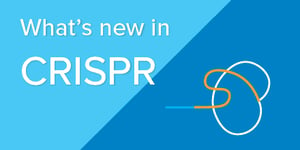 In this quarterly blog series, we’ll highlight a few of the new CRISPR plasmids available at Addgene. We will still periodically focus on specific CRISPR plasmid tools more in-depth, but we hope that this blog series will help you find new CRISPR tools for your research.
In this quarterly blog series, we’ll highlight a few of the new CRISPR plasmids available at Addgene. We will still periodically focus on specific CRISPR plasmid tools more in-depth, but we hope that this blog series will help you find new CRISPR tools for your research.
Improved nucleic acid sequence detection
Feng Zhang’s lab recently developed a platform called SHERLOCK (specific high-sensitivity enzymatic reporter unlocking) to detect single molecules of RNA or DNA. Now they have developed this further to provide multiplexed detection, higher sensitivity, and more.
-
Read the paper in Science
-
Find the new SHERLOCK plasmids
More precision with dual-nuclease Cas9-Cas9 chimeras
Scot Wolfe’s lab has developed dual-nuclease Cas9-Cas9 chimeras with higher target site activity and more predictable and precise deletion products compared to monomeric Cas9’s.
-
Read the paper in Nature Communications
-
Find the Cas9-Cas9 chimera plasmids
A modular toolkit for genome editing in plants
While there have been many Cas nucleases developed for plants, it has been difficult to compare the performance of different nucleases. Nicola Patron’s lab compared the efficiency and specificity of multiple wild-type and engineered variants of Cas nucleases. In doing so, they also created a modular toolkit for Cas-mediated genome engineering in plants.
-
Read the paper in bioRxiv
-
Find the plant genome editing toolkit
New Cas protein identified
Jennifer Doudna’s lab recently identified Cas14, a family of small DNA-targeting Cas proteins. Cas14 targets and cleaves ssDNA which they have adapted for detecting SNPs.
-
Learn more from this Addgene blog post
-
Read the paper in Science
-
Find the Cas14 plasmids
Anti-CRISPR proteins for optogenetic control of CRISPR-Cas9
Anti-CRISPR proteins that inhibit type II CRISPR systems were recently discovered in 2017. Now Dominik Niopek’s lab has adapted anti-CRISPR proteins for optogenetic control of CRISPR-Cas9. By combining AcrIIA4, a Streptococcus pyogenes Cas9 inhibitor, with the LOV2 photosensor from Avena sativa, light-mediated genome editing is now possible.
- Learn more from this Addgene blog post
-
Read the paper in Nature Methods
-
Find the anti-CRISPR plasmids
Tagging human transcription factors with GFP
Kevin White’s lab recently deposited a set of CRISPR plasmids to tag human transcription factors with GFP. As part of the Encyclopedia of DNA Elements (ENCODE), a consortium aimed to identify functional elements in the human genome, these donor plasmids will help researchers map transcription factor localization and binding via ChiP-seq.
-
Learn more about ENCODE
If you have a new CRISPR tool you’ve recently deposited to Addgene and you’d like it to be included in the next What’s New in CRISPR blog post, please let us know!
Additional resources on the Addgene blog
- Download the CRISPR 101 eBook
- Find our CRISPR 101 blog posts
- Read our CRISPR cheat sheet
Resources on Addgene.org
- Read our CRISPR guide
- Find CRISPR plasmids by function
- Find recently deposited plasmids
Topics: CRISPR, Other CRISPR Tools






Leave a Comment